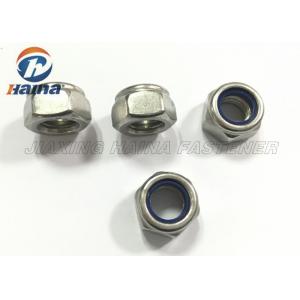DIN 985 304 Stainless Steel Hex Nylon Insert Lock Nuts For Locking Connector
Add to Cart

DIN 985 304 Stainless Steel Hex Nylon Insert Lock Nuts For Locking Connector
1. Product Description
A Square nylon-insert lock nut , also referred to as a lock nut, polymer-insert lock nut, or elastic stop nut, is a kind of nylock nut It is a nut with a nylock collar insert that resists turning.
Rely nylon washers to play a role in the locking nut, called nylon lock nuts, commonly referred to within the industry Nepalese cap. Mainly with threaded screw or bolt connection with the use, after locking nylon ring will be deformed, connecting both ends of the member to fill the gap, and thus play a role in locking.
Hot forging: refers to the raw material after a heated stamping, specific uses no special requirements, generally require the use of cold heading, because this surface finish, the material composition of the organization will be relatively more closely, there is relatively a large piece often hot heading process.
Hot forging has become an indispensable in modern industry, and increasingly important processing methods. Therefore, the development of induction heating equipment is also growing. Good selection of heating equipment, make the work more efficiently.
1 Scope This standard specifies the lock nut (the nut), the size of the locking device, technical requirements, acceptance rules and measurement methods. This standard applies to the design with a tapered bushing nut and locking devices, production, testing and user acceptance.
2 References The following standards contain provisions which, through reference in this standard, constitute provisions of the standard. At the time of publication, the editions indicated were valid. All standards are subject to revision, the standard parties should explore the possibility of using the latest version of the following standards. GB / T 192-1981 ordinary screw threads - Basic type GB / T 196-1981 common thread basic size (diameter 1 ~ 600 mm) GB / T 272-1993 Rolling Code Method GB / T 699-1988 quality carbon steel structural conditions GB / T 1804-1992 general tolerances for linear dimensions without individual tolerance GB / T 2516-1981 common thread offset table (diameter 1 ~ 355 mm) GB / T 5796.1-1986 trapezoidal thread profile GB / T 5796.3-1986 substantially trapezoidal thread size GB / T 5796.4-1986 trapezoidal thread tolerance GB / T 6930-1986 Rolling vocabulary GB / T 8597-1988 Rolling packaging JB / T 3574-1997 Rolling products marked JB / T 8921-1999 Rolling commodity parts and inspection rules.
Terminology 3 Terms used in this standard in compliance with the GB / T 6930's.
This standard specifies the torque type steel hexagon nuts and mechanical performance of the marker system, indicators, test methods and marking. This standard applies to carbon steel or alloy steel, of a width edge in line with the provisions of GB 3104, the nominal height ≥0.8D, need to provide valid proof load and torque, the thread diameter is 3 ~ 39mm coarse level of 6H nut. In addition to the effective torque portion that thread sizes and tolerances according to press GB 193, GB 196 and GB 197 regulations. Nut operating temperature range should be consistent: without plating of all metal nut: -50 ℃ ~ + 300 ℃ after plating of all metal nut :: - 50 ℃ ~ + 230 ℃ non-metallic elements embedded nut: -50 ℃ ~ + 120 ℃ this standard does not apply to special performance requirements of nuts (such as weldability and corrosion resistance). Stainless steel, carbon steel or non-ferrous metal fine tooth alloy steel lock nut or nut thin, performance and test methods can be used by mutual agreement specified in this standard effective torque
2. Specification
root mother, pine nuts, satisfied that the child.
2. Application: locking connector through the wire, or other tube.
Nut works by using friction between the nut and bolt self-locking.
However, in such a dynamic load lock reliability is reduced. In
some important occasions and we'll take some anti-loosening
measures to ensure the reliability of the locking nut. Locknut is
one of them against rotation.
Lock nut anti-loosening effect depends on the merits of a nut and
bolt engaging interaction between threads. Currently engaging way
to improve the interaction between the threads there are many, such
as structural improvements Spiralock thread nut, nylon nut nylon
increasing roughness, surface treatment, thread and the like.
3. Application
Application: locking connector through the wire, or other tube.
Nut works by using friction between the nut and bolt self-locking.
However, in such a dynamic load lock reliability is reduced. In
some important occasions and we'll take some anti-loosening
measures to ensure the reliability of the locking nut. Locknut is
one of them against rotation.Role: Principles for locking effect:
Vice screw during installation, the threaded bolt nut embedded in
nylon extrusion, such as nylon deformed after installation, and
nylon thread completely press contact, extruded nylon bolt produces
a lot of resilience, this force so that the bolt is not easy to
loose nylon self-locking nut is a new high-vibration-resistant
locking fasteners, can be applied to a temperature of -50 ~ 100 ℃
various mechanical, electrical products .
4. Advantages
As a fully integrated company, we do it all. We make the materials, build the application equipment and handle all aspects of operations from formulating custom chemical compositions and coating fasteners to providing advanced in-line inspection, packaging and delivery services. Find out how we can assist you on your next project.
1. Top quality control. Quality is the soul of company, is the
impulsion to drive us forward constantly.
2. Competitive price.
3. Customer's design and logo are welcome.
4. Good after sales service. Any small problems will be solved at
once.!
5. Efficiency! The many years of experience of the team can help
you with your requirements.
5. More pictures

